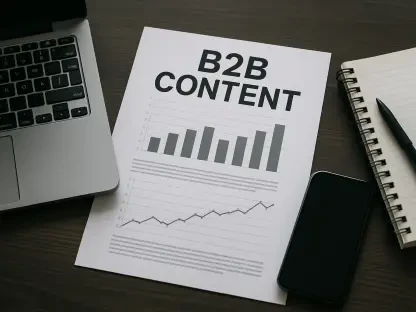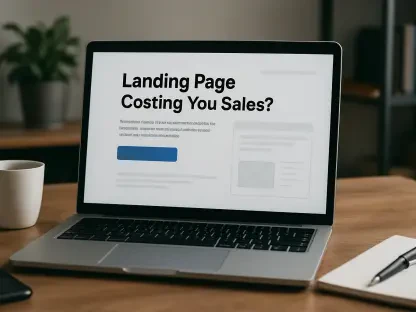Imagine a groundbreaking AI marketing strategy, backed by a hefty budget and executive approval, failing to launch despite months of meticulous planning by a dedicated team. Picture the unveiling of an AI-driven campaign poised to revolutionize customer engagement, only to see it languish in limbo six months later as progress stalls, resources dwindle, and frustration mounts, even with the CMO’s initial enthusiasm. This scenario, far too common in today’s corporate landscape, underscores a critical gap in leadership that can make or break AI integration in marketing.
The significance of this issue cannot be overstated. As AI continues to reshape how brands connect with audiences through personalized ads and predictive analytics, the difference between success and failure often hinges not on technology, but on the nature of executive support. This article delves into why active sponsorship—engaged, hands-on leadership—is the linchpin for transforming AI potential into measurable results, exploring real-world challenges, actionable insights, and expert perspectives that highlight its undeniable importance.
When AI Ambitions Hit a Wall at the Executive Level
Many marketing teams have faced the bitter reality of an AI project grinding to a halt despite having all the right ingredients on paper. A robust plan, a secured budget, and a nod from the top should spell success, yet initiatives frequently falter. The root cause often lies in a lack of sustained leadership engagement, leaving teams to navigate complex organizational hurdles without adequate support.
Consider a hypothetical case where a marketing department secures approval for an AI tool to optimize ad targeting. The executive signs off with a casual “keep me updated,” but offers no further involvement. Without someone to champion the project through inevitable roadblocks like data access issues or interdepartmental conflicts, momentum fades, and the vision remains unrealized.
This pattern reveals a deeper truth: a signature on a budget line is not enough. AI in marketing demands more than passive endorsement; it requires leaders who are willing to roll up their sleeves and ensure the path forward remains clear. The stakes are high in a competitive market where delays can cost both opportunities and credibility.
The Critical Intersection of AI and Marketing Leadership
AI’s transformative potential in marketing—think hyper-personalized campaigns or real-time customer insights—has never been more evident. Yet, the journey from concept to execution is fraught with challenges that technology alone cannot solve. Organizational silos, unclear objectives, and misaligned priorities often derail even the most promising initiatives.
Leadership plays a pivotal role in bridging this gap. When executives remain distant, merely approving plans without deeper involvement, marketing teams are left vulnerable to internal friction and stalled progress. Active sponsorship, on the other hand, positions leaders as catalysts who tackle these barriers head-on, ensuring that AI strategies align with business goals.
The impact is clear in datstudies from McKinsey indicate that 70% of digital transformation efforts fail due to insufficient executive support. For marketing, where AI integration can redefine customer engagement, the absence of committed leadership risks not just wasted resources, but also missed chances to stay ahead in a data-driven arena.
Breaking Down Sponsorship: Passive Pitfalls vs. Active Triumphs
Understanding the contrast between passive and active sponsorship sheds light on why so many AI marketing projects struggle. Passive sponsorship, often seen as a detached “sign-and-forget” approach, involves leaders approving budgets or requesting updates without engaging in the gritty details. Such minimal involvement frequently leaves teams stranded when obstacles arise, as no one with authority steps in to resolve conflicts or maintain focus.
Active sponsorship, by contrast, transforms outcomes through direct intervention. Leaders who adopt this style use their influence to dismantle barriers, facilitate collaboration across departments, and keep the project’s core objectives intact. An active sponsor might, for example, mediate a dispute between marketing and IT to ensure seamless access to AI tools, preventing delays that could derail the entire effort.
The consequences of this divide are stark, especially in marketing’s fast-paced environment. AI projects like customer segmentation or predictive modeling require tight coordination across teams. Without active sponsorship, the likelihood of failure skyrockets, squandering both time and investment in a landscape where agility is paramount.
Real-World Perspectives on Leadership’s Role in AI Adoption
Insights from industry leaders reinforce the necessity of active sponsorship in driving AI success. In the book “Hyperadaptive,” the author critiques passive sponsorship as a form of leadership neglect, a view shared by many in the marketing field. This perspective highlights how disengaged oversight can doom even well-funded initiatives.
A marketing executive recently recounted a telling experience: after approving an AI project, they assumed their role was complete until progress stalled over technical access issues. Only by stepping in regularly to push for cross-departmental cooperation did the project regain traction. This hands-on approach turned a potential failure into a learning opportunity about the demands of true leadership.
Supporting these anecdotes, research from the Project Management Institute shows that active executive involvement increases project success rates by 40%. For marketing teams integrating AI, these findings emphasize that leadership must extend beyond approval to persistent, visible commitment, ensuring initiatives don’t falter under preventable challenges.
From Vision to Victory: Actionable Steps for Marketing Leaders
Marketing leaders aiming to champion AI initiatives can adopt practical strategies to shift from passive to active sponsorship. One effective approach is to personally engage with the AI tools in use. By spending time exploring platforms for data analytics or content creation, leaders gain firsthand insight into their capabilities and limitations, while also demonstrating to teams that the technology is a priority worth understanding.
Another key step involves proactively addressing obstacles. Instead of merely seeking progress reports, leaders should organize regular, focused discussions to identify and resolve immediate hurdles. Using their authority to break down barriers—such as securing IT support or aligning departmental goals—ensures that teams aren’t left grappling with systemic issues alone.
Finally, defending the project’s original vision is crucial. Leaders must attend critical meetings, challenge unnecessary compromises, and consistently reinforce the purpose behind the AI effort, whether it’s boosting campaign ROI or deepening customer insights. These actions protect the initiative from dilution and keep everyone aligned on delivering impactful results.
Reflecting on Leadership’s Lasting Impact
Looking back, the journey of integrating AI into marketing revealed a profound lesson: success hinged on the depth of leadership involvement. Teams that struggled often did so under the weight of passive sponsorship, where initial approvals faded into neglect. Those that thrived benefited from leaders who stayed engaged, turning challenges into stepping stones.
The path forward demanded a shift in mindset—executives had to become active participants, not distant overseers. By embracing hands-on strategies, from mastering AI tools to dismantling roadblocks, leaders paved the way for innovation to flourish. For marketing organizations still navigating this terrain, the next step is clear: commit to active sponsorship as the cornerstone of AI-driven transformation, ensuring that vision translates into victory.









